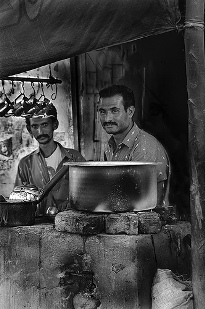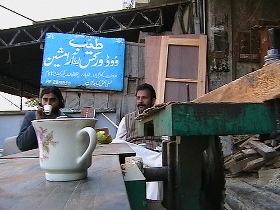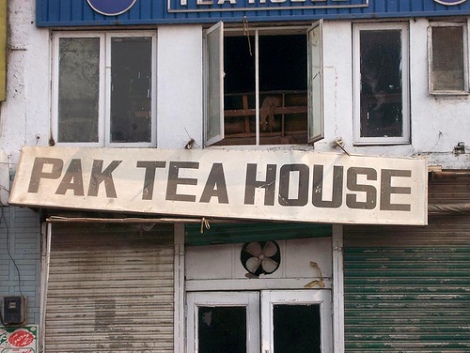Owais Mughal
Answer is US $220 million worth of it. Yes, it is true. Pakistan imported this much worth of tea in fiscal year 2006.
While years ago tea drinking used to be a fashionable habit, it is now our national habit, addiction and part of our evolutionary culture.  Part of our culture in a sense that guests are now offered tea as a minimum. Guests also expect a cup of tea as a minimum when they visit somebody. The cultural fusion of tea in our daily lives is so complete that I recently had to bear a beautiful wedding song sacrifced to our tea habit. The real song goes like this:
Part of our culture in a sense that guests are now offered tea as a minimum. Guests also expect a cup of tea as a minimum when they visit somebody. The cultural fusion of tea in our daily lives is so complete that I recently had to bear a beautiful wedding song sacrifced to our tea habit. The real song goes like this:
banno teray abba ki ooNchi haveli
banno meiN DhooNDta chala aaya
but during a song competition, groom’s side plagiarized the song to:
banno teray abba ka chai ka khokha
banno meiN khaulta chala aaya
If you go to any Pakistani commercial bazaar (market), you will notice that all shopkeepers drink tea en-masse atleast twice daily. There is a whole institution in place where cups full of tea are distributed in the whole market and then collected later on.  Tea is even offered on credit. One can choose from a variety of payment plans like ‘pay as you go’, pay weekly or monthly. Tea is also offered to prospective ‘gaahak’ (buyer) by the shopkeeper to show how sincere he/she is in upcoming transaction.
Tea is even offered on credit. One can choose from a variety of payment plans like ‘pay as you go’, pay weekly or monthly. Tea is also offered to prospective ‘gaahak’ (buyer) by the shopkeeper to show how sincere he/she is in upcoming transaction.
The $220 million amount seemed astronomical to me and it shocked me for few seconds and that is what prompted me to write these lines. Good or bad I don’t know because I myself contribute roughly $100 a year to this fashion. What to hide from you, I am sipping on a cup of tea even while writing these very lines. But after reading this number, I feel as if there is a brewing storm in my tea cup.
Fountain of Youth?
 But then all is not bad about tea. Tea contains antioxidants which are good for us. One of my good friends who recently did research on tea tells me that during digestion of food besides energy for our daily activities, high energy free oxygen radicals are also produced. These highly mobile particles hit DNA in the cells, thus causing severe damage to DNA. This in turn could lead to defects in DNA which is the primary cause of cancer. Antioxidants found in tea neutralize free Oxygen radicals thus minimizing damage to DNA and hence cancer.
But then all is not bad about tea. Tea contains antioxidants which are good for us. One of my good friends who recently did research on tea tells me that during digestion of food besides energy for our daily activities, high energy free oxygen radicals are also produced. These highly mobile particles hit DNA in the cells, thus causing severe damage to DNA. This in turn could lead to defects in DNA which is the primary cause of cancer. Antioxidants found in tea neutralize free Oxygen radicals thus minimizing damage to DNA and hence cancer.
A recent research published in a leading journal “Nature” shows that DNA damage can also lead to premature aging in humans, in addition to cancer. Therefore, each time when you sip from your cup of tea, think like you are sipping from fountain of youth.
There are reports that Government of Pakistan is now awakening to this massive demand of a massive population of 160 million Pakistanis. There are reports of a plan to grow tea locally in Pakistan on 4000 acres. This will be done in private sector. Semi Government sectors will also chip in by growing tea at 800 acres in NWFP, 200 acres in AJK and 50 acres in FATA. This will still be like putting ‘ooNT ke muNh meiN zeera’ (a single cumin seed in a camel’s mouth) but better than nothing.
There is another angle to this national addiction. It gives Pakistan a teeny-tiny leverage in World trade. I’ve read in news that when India and Pakistan were in serious trade negotiations in 2004, then of all the people, it made Government of Kenya very nervous. Kenya gets a big share of our US $220 million up-for-grabs money and they were probably wary of losing its share to India’s Assamese and Darjeeling produced black tea.
I personally like Darjeeling black tea over Kenyan brands but then who am I to decide about World trade. I’ll end the post with this plagiarized sher:
“chai” se gharz-e-nishaat hai kis rosiaah ko
ik gona-e-be-khudi mujhay har dum chahiyay
Pakistan’s National Tea Research Institute:
Pakistan has established a National Tea Research Institute in Mansehra which works under Pakistan Agricultural Research Council (PARC). The institute has a tea garden spread on 33 acres. Mansehra was chosen for tea research because of its hilly location with lots of rainfall. The web page of this tea research institute is here.ÂÂÂ
References:
(1) Photos for this post have been taken from flickr.com. Clicking on the photos will take you to their source website.
(2) Source of some of the information for this post is from here.
Previos ATP post on ‘chai’ (tea): Chai Chahiyay




















































[quote comment=”51482″]Pakistan has established a National Tea Research Institute in Mansehra which works under Pakistan Agricultural Research Council (PARC). The institute has a tea garden spread on 33 acres. Mansehra was chosen for tea research because of its hilly location with lots of rainfall. The web page of this tea research institute is at:
http://www.parc.gov.pk/ntri.html%5B/quote%5D
I don’t really expect much from PARC.
Pakistan has established a National Tea Research Institute in Mansehra which works under Pakistan Agricultural Research Council (PARC). The institute has a tea garden spread on 33 acres. Mansehra was chosen for tea research because of its hilly location with lots of rainfall. The web page of this tea research institute is at:
http://www.parc.gov.pk/ntri.html
last winter i developed a taste for green tea and lemon grass, and the way to enjoy that sort of tea properly is to stop at any qehwa khana when travelling btw pindi and peshawar! truck drivers get the best qehwa, lekin then again…apnay haath ki ghar ki chai ki aur baat hai!
waisay does qehwa qualify as chai?
Some lyrics of a song i head years back on the radio…heard it once and still remember the lyrics…and yes, i was drinking tea then :D
”
Pehlay pani pakkda, haan paani pakkda!
Fir Patti pakkdi haan patti pakdi!
Pak pak ke hondi kaali syaa!
Sab kehnday pak gayee cha cha!
“
Usually tea is grown in hilly or rolling terrain, where it is hard to grow other cash crops. Hence, tea plantations will likely not come at the expense of other crops.
While NWFP has the hills, does it have the climate to support tea cultivation? Typically, tea is grown in cool but humid environments. For instance, the Darjeeling hills and Assam have very high levels of precipitation, as do the regions of Kenya and Sri Lanka that cultivate tea. The same is the case with the regions in South India that grow tea – the Munnar region of Kerala and the Nilgiri hills (near the hill station of Ooty) in Tamil Nadu.
Interestingly, Bangladesh is the next country that is trying to cultivate tea in significant quantities. It has the climate and some parts of it have the terrain, but until recently, there was not much Government support for the tea industry there. Things are changing now and we might see Bangladesh emerging as the next major tea producer in a few years if things go well.
Chai is great and is even beginning to catch on in the States, where most coffee shops now offer “hot or iced Chai”; it tastes like crap of course, but its interesting that the Ami version is becoming a popular drink. Tea brewing is an art however and American coffee shops cannot be expected to “get it right” esp. given their approach to food preparation and consumption.
I have heard before about the new attempts to get tea plantations growing in Pakistan, all I can say is that coffee and tea are not indigenous to Kenya either, but Kenya is now a big exporter of both of these. If the hilly regions can support tea, then why not try it.